India
Devendra Fadnavis Blames ‘Chhaava’ Movie for Surge in Anger Towards Aurangzeb

Contents
Introduction to the Controversy
The historical figure of Aurangzeb continues to evoke strong sentiments within the Indian cultural and political landscape. His reign as the sixth Mughal emperor, which lasted from 1658 to 1707, is often scrutinized for its perceived intolerance and oppressive policies towards non-Muslims, particularly Hindus. This contentious legacy renders Aurangzeb a polarizing subject in Indian history, eliciting both admiration and repudiation. Proponents of a more favorable interpretation consider him a ruler who expanded the empire, while detractors view him as a symbol of persecution and religious fanaticism. This politic dichotomy underpins a broader debate over historical representation, identity, and nationalism in contemporary India.
The recent film ‘Chhaava’ has further intensified discussions surrounding Aurangzeb. This cinematic portrayal, which presents a narrative that may be perceived as critical of the emperor’s policies, has sparked widespread public sentiment against him. Devendra Fadnavis, a prominent political figure, has attributed the surge in anger towards Aurangzeb largely to the film’s framing of his character. The movie has not only revived historical grievances but has also catalyzed a resurgence of public discourse on the legacy of Aurangzeb in the modern context.
Critics of the film argue that it oversimplifies a complex historical narrative, potentially distorting perceptions of Aurangzeb and igniting social tensions. The emotional responses elicited by ‘Chhaava’ illustrate how media representations can significantly influence collective memory and identity. As such, this instance serves as a reminder of the potent interplay between culture, history, and contemporary political dynamics in India.
Overview of the Movie ‘Chhaava’
‘Chhaava’ is a significant cinematic work that delves into the events surrounding the life and legacy of the Mughal emperor Aurangzeb. The film presents a narrative that is centered on historical events while incorporating dramatized elements to enhance storytelling. At the heart of the plot is the dichotomy between the emperor’s rule and the resistance faced from local rulers, specifically highlighting the cultural and social dynamics of the era. The portrayal of Aurangzeb in ‘Chhaava’ is notably distinct from the traditional narratives that often romanticize or vilify historical figures, thereby inviting viewers to engage with a more nuanced perspective.
The filmmakers of ‘Chhaava’ aimed to provide a comprehensive look at the complexities of Aurangzeb’s character, depicting him as a ruler shaped by the socio-political climate of his time. This interpretation challenges conventional portrayals that typically depict him solely as a tyrant. Through evocative storytelling and rich cinematography, the film attempts to paint a broader picture of Aurangzeb’s reign, illustrating the conflicts that arose during his governance, while also considering the perspectives of those who opposed him.
Central to the film’s narrative is the theme of identity and cultural heritage, especially concerning the impact of Aurangzeb’s policies on the region’s diverse populace. ‘Chhaava’ navigates through intricate relationships between various historical figures and examines how such relationships were influenced by power struggles and ideological disagreements. It raises pertinent questions regarding the legacy left by Aurangzeb, making viewers ponder his significant role in shaping the historical landscape of India. By doing so, the filmmakers intend to provoke thought and discussion surrounding the complexities of historical narratives and their interpretations in modern cinema.
Devendra Fadnavis’s Statement
Devendra Fadnavis, the former Chief Minister of Maharashtra, recently drew significant attention with his remarks concerning the film “Chhaava.” During a public address, Fadnavis asserted that the movie has acted as a catalyst, intensifying emotions towards the historical figure Aurangzeb. His comments came at a time when the film had sparked discussions across various circles, highlighting the complexities of historical narratives in contemporary society.
In his statement, Fadnavis noted that the film’s portrayal of Aurangzeb has rekindled sentiments related to historical grievances. By referencing this cinematic representation, he suggested that “Chhaava” has not only affected the perception of Aurangzeb but also influenced a segment of the public to voice their frustrations more vehemently. This assertion alluded to the deeper socio-political dynamics at play, as individuals reflect on historical figures and events that continue to shape their identity and regional sentiments.
Fadnavis’s phrasing emphasized the emotional weight carried by the film, indicating that it has resonated with people’s already existing sentiments towards Aurangzeb, which may have been dormant. His remarks illustrate how media, particularly film, can manipulate historical narratives and provoke reactions that may lead to increased public discord. Additionally, he highlighted the responsibility of filmmakers in responsibly representing historical figures, indicating that this portrayal can have real-world consequences.
The implications of Fadnavis’s statement extend into the realm of political discourse, as it raises questions regarding the intersection of art and politics. It invites a broader discussion on how cultural products like films can affect public sentiments, stoke historical animosities, and even influence contemporary political landscapes. As such, this commentary is significant, reflecting the ongoing dialogues surrounding identity, history, and representation in Indian society.
Public Reaction to Fadnavis’s Remarks
Following Devendra Fadnavis’s remarks linking the film ‘Chhaava’ to the escalating anger towards the historical figure Aurangzeb, public response has been widely varied, encapsulating a spectrum of support and criticism. These comments have generated discussions across social media platforms, forums, and various public gatherings, reflecting the multifaceted nature of the issue.
On one hand, a section of the populace has expressed agreement with Fadnavis, asserting that the portrayal of Aurangzeb in the film is pivotal in shaping public sentiment. Supporters argue that the film brings to light the grievances associated with Aurangzeb’s rule, making the historical narrative more accessible to contemporary audiences. For instance, one Twitter user remarked, “Films like ‘Chhaava’ spark vital conversations about our history—this is necessary for national pride.” Such sentiments underline the belief that cinematic narratives can significantly influence public perception of historical figures and events.
Conversely, there exists a substantial faction that vehemently contests Fadnavis’s stance. Critics argue that his remarks promote divisiveness, and some suggest that attributing cultural emotions to a film oversimplifies complex historical realities. One social media commentator stated, “Blaming a film for societal anger is misdirected; we need to engage in deeper dialogues rather than sensationalizing the past.” This critique emphasizes the importance of discernment in understanding historical contexts, advocating for a balanced view rather than a polarized interpretation.
Overall, the public reaction to Fadnavis’s comments reveals a significant divide, reflecting broader societal attitudes toward history, culture, and media influence. The discourse surrounding ‘Chhaava’ and Aurangzeb has highlighted the need for thoughtful discussions about historical narratives and their contemporary implications.
Historical Context of Aurangzeb’s Legacy
Aurangzeb, the sixth Mughal emperor, ruled from 1658 to 1707, and his reign is often characterized by controversy and complexity. His policies and actions have prompted diverse interpretations, resulting in a polarizing legacy that continues to provoke strong emotions in contemporary India. On one hand, he is recognized for expanding the Mughal Empire to its greatest territorial extent, which brought about a significant degree of political and administrative consolidation. However, his methods drew criticism for being intolerant, particularly towards non-Muslim communities, leading to perceptions of his rule as oppressive and authoritarian.
The historical context of Aurangzeb’s reign is essential to understanding the polarized opinions surrounding him. His decision to abolish the religious tax known as the jizya on non-Muslims is frequently cited as a move that alienated many Hindus. Numerous historical accounts portray a ruler who was stringent in his Orthodox Islamic beliefs, often enforcing Sharia law that constrained the cultural and religious freedoms available to his subjects. These stringent measures incited resistance and rebellion, notably from figures such as the Marathas, who viewed his policies as detrimental to their own social and political autonomy.
Conversely, some historians argue that Aurangzeb was a pragmatic ruler who sought to maintain peace and stability in a diverse empire. They highlight instances of his administrative reforms and efforts to promote agricultural development. This nuanced perspective challenges the prevailing narrative of Aurangzeb as solely a tyrant. The interpretation of his reign’s impact is shaped by various socio-political factors and historical contexts, which illustrate the complexities of his legacy. Consequently, the historical significance of Aurangzeb continues to evoke heated debates, as groups across the political spectrum wrestle with the implications of his rule in contemporary society.
Impact of Cinema on Historical Perspectives
The intersection of cinema and historical narratives has long been a subject of intrigue, influencing public perception in ways that are profound and often lasting. Films have the power to shape cultural memory, presenting historical figures and events in a manner that cultivates specific interpretations in the minds of audiences. One notable example is the film ‘Chhaava,’ which portrays the historical figure of Aurangzeb in a manner that has sparked considerable public discourse regarding his legacy. The narrative woven through such cinema can alter long-standing perceptions by emphasizing certain traits while downplaying others.
Movies often serve as a reflection of contemporary societal views, which can then reinterpret historical characters and events through a modern lens. The portrayal of Aurangzeb in ‘Chhaava’ has placed him under scrutiny, leading to a surge of anger and critical examination of his historical actions. This transformation of narrative not only impacts individual understanding but can shift collective memory, influencing how generations perceive historical events. When filmmakers choose to highlight specific aspects of a historical figure’s life, they essentially rewrite parts of history for their audience. Such reimaginings can evoke national pride or invoke social controversies, thus prompting discussions about the complexities of historical figures.
This phenomenon is not isolated; history is replete with examples where cinema has played a pivotal role in shaping opinion. Films like ‘Lagaan’ and ‘Gandhi’ have contributed to national identity discussions, each shaping the narrative around resistance and colonialism. The influence of cinema extends beyond entertainment; it plays a salience in cultural education by providing a framework through which society understands its past. Recognizing this, it is crucial to approach films as more than just stories, understanding their capacity to mold historical perspectives and cultural memory.
Political Ramifications of Historical Narratives
Devendra Fadnavis’s comments linking the film ‘Chhaava’ to a rising discontent towards the Mughal emperor Aurangzeb raise significant questions about the role of historical narratives in contemporary Indian politics. The choice of a historical figure like Aurangzeb, notorious for his perceived intolerance, reflects how the past is often reinterpreted to serve present-day political agendas. Political leaders, including Fadnavis, strategize by invoking historical references that resonate with specific voter bases, thus making history a tool of political persuasion.
Also read : The Whitewashing Controversy: Sambhal Mosque and the Allahabad High Court’s Decision
The public’s reaction to Fadnavis’s statement indicates a complex interplay between entertainment media, like cinema, and political sentiment. ‘Chhaava’, by portraying historical events, can inadvertently shape public perception and stimulate communal tensions. Incidents such as these highlight the sensitive nature of India’s communal relations, where discussions about historical figures can provoke strong emotions and even backlash. As evidenced by Fadnavis’s remarks, political figures are acutely aware that popular culture can ignite nationalistic or sectarian sentiments, further polarizing communities.
By framing Aurangzeb as a symbol of historical grievances, political narratives can rally certain demographics while alienating others. These divisive strategies often culminate in heightened tensions, especially in a diverse society like India, where multiple communities co-exist. Furthermore, the selective emphasis on certain historical events can reinforce prevailing ideological divisions, affecting social harmony. Political parties may utilize such narratives to solidify their electoral base, but the ramifications can be enduring, altering how history is viewed in communal contexts.
In summation, the intertwining of historical narratives and political strategy, exemplified by Fadnavis’s comments, exemplifies a broader trend in Indian politics where the past is continually revisited for present gains. Understanding this dynamic is crucial in navigating the complexities of Mumbai’s political landscape and its implications for national unity.
Future of Historical Films in India
The landscape of Indian cinema has witnessed significant transformations in recent years, particularly in the realm of historical films. As filmmakers increasingly turn to the rich tapestry of India’s past for inspiration, the future of historical storytelling appears promising yet challenging. The genre has gained traction with audiences, but it carries the pivotal responsibility of portraying history with accuracy and sensitivity. The merging of compelling narrative with factual integrity is essential to uphold the trust of viewers who are often passionate about their heritage.
One prominent trend is the incorporation of modern storytelling techniques, which aim to make historical narratives more relatable to contemporary audiences. Films like “Tanaav” and “Karnan” have demonstrated that blending innovative cinematic elements with historical themes can yield critical acclaim and commercial success. This trend not only increases audience engagement but also encourages filmmakers to delve deeper into the complexities of historical figures and events, offering a multi-dimensional view rather than a simplistic representation. Additionally, the advent of streaming platforms has catalyzed the growth of historical content, allowing a broader audience reach without the constraints of traditional box-office models.
Conversely, there are significant challenges that filmmakers must navigate. The task of depicting contentious historical narratives is fraught with risk, as it can provoke strong reactions from various factions within society. Filmmakers need to approach these topics carefully, ensuring they maintain historical accuracy while also considering the diverse perspectives that shape narratives around historical figures, such as Aurangzeb. This balancing act requires a thorough research process and often the involvement of historians and experts to validate interpretations, thereby lending credibility to the cinematic representation.
In conclusion, the future of historical films in India stands at a crossroads; it offers immense potential for creative exploration while demanding a high degree of responsibility from filmmakers.
Conclusion: The Role of Art in Shaping History
The recent remarks by Devendra Fadnavis regarding the movie ‘Chhaava’ have ignited discussions about the profound impact that art, particularly cinema, can have on societal perceptions of historical figures and events. As evidenced in the arguments presented throughout this blog post, artistic representations often reflect existing cultural sentiments while simultaneously influencing public opinions and attitudes towards historical narratives. In this instance, the portrayal of Aurangzeb in ‘Chhaava’ has sparked a surge in anger and debate concerning the legacy of this Mughal ruler, highlighting the power of film as both a mirror and a mold for collective memory.
Film, as a form of art, extends beyond mere entertainment. It serves as a conduit for dialogue and introspection about historical characters and their actions, inviting audiences to reassess their understanding of the past. The narratives portrayed on screen can either reinforce stereotypes or challenge them, ultimately shaping cultural consciousness. The reception of ‘Chhaava’ illustrates how a film can catalyze discussions on nationalism, identity, and historical interpretation, demonstrating that modern media plays a pivotal role in how history is perceived by society.
In contemporary discourse, it is critical to approach historical narratives with nuance and depth. As discussions regarding figures like Aurangzeb continue to evolve, it is essential for consumers of art—whether viewers, critics, or scholars—to engage with these representations thoughtfully. Historical accuracy, artistic license, and current socio-political climates must be taken into account when evaluating the significance of art in shaping narratives. By fostering informed discussions about our past, we can promote a more comprehensive understanding of history and its multifaceted implications on present-day society.
Crime
Vandalism by Kanwariyas in Meerut: School Bus Attacked, FIR Registered

Contents
Meerut, July15,2025
Tension flared in Meerut’s Sadar Bazar area after a group of Kanwariyas allegedly vandalized a school bus during the annual Kanwar Yatra. The incident occurred on Monday, July 14, prompting swift police action.
According to the complaint filed by Sub-Inspector Gaurav Kumar, 4-5 unidentified youths got into an argument with the bus driver. The confrontation escalated quickly, with the accused allegedly hurling abuses, issuing death threats, and smashing the bus windows.
Upon receiving the alert, police rushed to the spot and found the bus in a damaged condition, surrounded by a large crowd.
Bus Windows Shattered by Kanwariyas
Confirming the incident, Circle Officer (CO) Santosh Kumar of Meerut Cantonment said the police had been informed about a scuffle involving a group of youths and the bus driver. “They had broken the windows of the bus. We immediately reached the spot and ensured the safety of both the driver and the vehicle,” he stated.
FIR Lodged, Investigation Underway
A case has been registered under various sections of the Bharatiya Nyaya Sanhita (BNS), and efforts are on to identify the culprits through video footage. Officials have assured that strict legal action will be taken against those found guilty.
India
A Milestone Towards Gaganyaan: PM Modi Welcomes Group Captain Subhanshu Shukla After Historic Space Mission
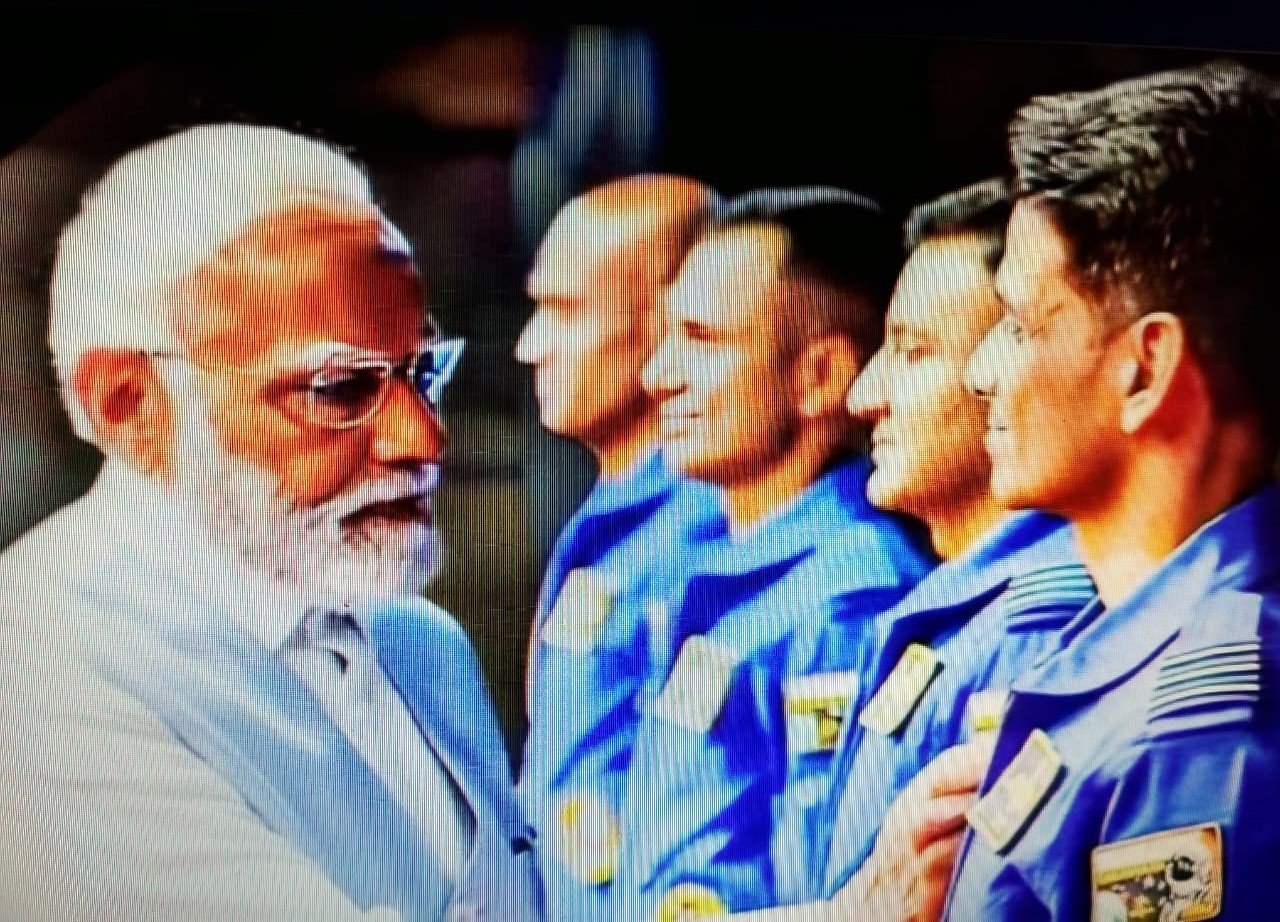
New Delhi, July15,2025
Prime Minister Narendra Modi has lauded Group Captain Subhanshu Shukla for his successful return from space, calling it a proud moment for the nation and a significant step toward India’s ambitious Gaganyaan mission.
Taking to social media, PM Modi wrote,
“I join the entire nation in welcoming Group Captain Subhanshu Shukla as he returns to Earth from his historic space mission. As the first Indian to visit the International Space Station, Subhanshu has inspired millions with his dedication, courage, and pioneering spirit. This marks another milestone on the path toward our own human spaceflight mission – Gaganyaan.”
“Touching the skies, lifting India’s dreams”
Defence Minister Rajnath Singh also expressed pride over the successful completion of the Axiom-4 mission. In a heartfelt social media post, he wrote:
“Group Captain Subhanshu Shukla’s successful return from the historic Axiom-4 mission is a moment of immense pride for every Indian. He has not only touched space but has elevated the dreams of India to new heights.”
Singh further emphasized that Subhanshu’s journey to and from the International Space Station is not merely a personal achievement but a major stride in India’s expanding space ambitions.
“I pray for his continued success in all future endeavors,” he added.
Subhanshu Shukla’s mission marks a new chapter in India’s space exploration story, strengthening the country’s position on the global stage and inspiring the next generation of Indian astronauts.
Crime
Tension in Jaipur’s Ramganj Area After Alleged Harassment Incident Sparks Stone-Pelting Between Communities

Contents
Jaipur, July 15,2025
Tension gripped the Ramganj area of Jaipur on Saturday after an alleged incident of harassment involving a woman escalated into a violent clash between two communities. The confrontation, which began as a verbal dispute, quickly turned into stone-pelting, causing panic in the neighborhood.
The incident occurred in the Babu Ka Tika locality, a part of Ramganj known for its sensitive history. According to eyewitnesses, a few young men from one community allegedly misbehaved with a local woman. When members of the other community confronted them, the situation escalated rapidly. What started as an argument soon turned into chaos, with both sides hurling stones at each other.
Several people were reportedly injured in the clash, although the police have not yet released an official statement regarding the number or severity of the injuries. Locals also reported damage to nearby shops and vehicles, adding to the fear and anxiety in the area.
Police forces rushed to the scene as soon as the incident was reported. To prevent further escalation, additional security personnel were deployed, and patrolling has been intensified throughout the neighborhood. The situation is currently under control, but authorities are maintaining a heightened security presence in the area as a precaution.
Ramganj is considered one of Jaipur’s most densely populated and communally sensitive areas, with a history of similar tensions. Given the seriousness of the incident, the police have launched a full investigation. CCTV footage from the area is being reviewed to identify those involved in the violence.
Officials have assured that strict action will be taken against anyone found responsible. The local administration has urged residents not to pay heed to rumors and to maintain peace. Authorities emphasized that no one will be allowed to disturb law and order under any circumstances.
Andhra Pradesh
Andhra Pradesh: Class 9 Student Dies After School Fight with Classmate in Bobbili
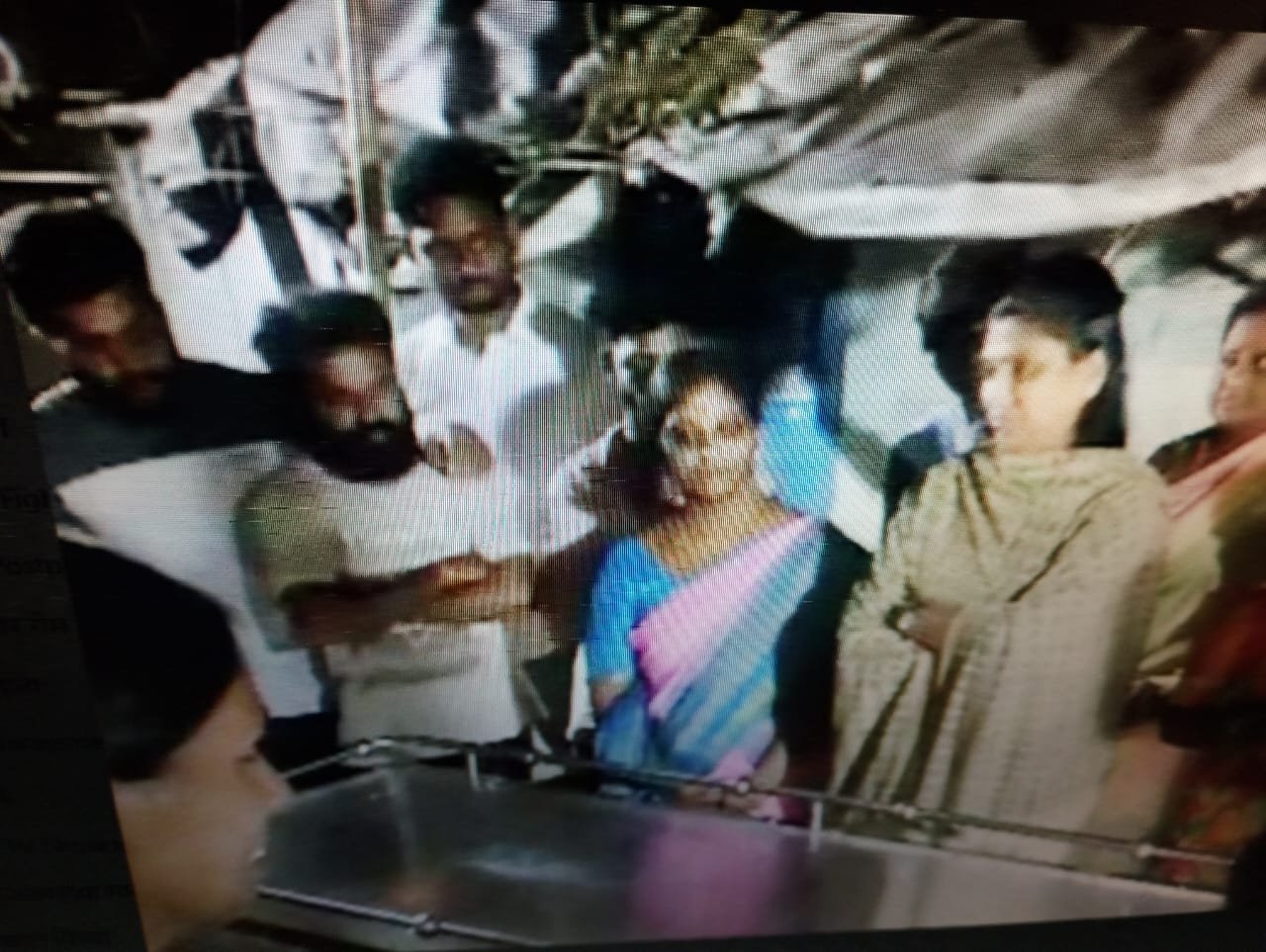
Andhra Pradesh, July15,2025
In a tragic incident from Bobbili town in Andhra Pradesh, a 14-year-old Class 9 student died after a scuffle with a classmate moments after school got over. The boy, identified as Sundarada Karthik, reportedly got into a fight near the Bobbili Fort, where he was punched by his classmate, collapsed, and later succumbed to his injuries at the hospital.
According to police sources, Karthik, a resident of Ravu Gari Street and a student of Class 9, frequently argued with a fellow classmate over petty issues. Their rivalry had been escalating for some time.
On Monday, just after the school had closed for the day, the two boys reportedly encountered each other again near the Bobbili Fort. According to eyewitness accounts and police reports, Karthik allegedly provoked his classmate and challenged him to a fight. The argument quickly turned physical. During the altercation, the other boy is said to have punched Karthik, who fell unconscious on the spot.
He was immediately rushed to a nearby hospital, but doctors declared him dead on arrival.
The incident has shocked the local community and raised concerns about rising aggression among schoolchildren. Police are investigating the matter and questioning witnesses to determine the exact sequence of events.
Crime
Death Sentence of Indian Nurse Nimisha Priya Postponed, Major Update from Yemen
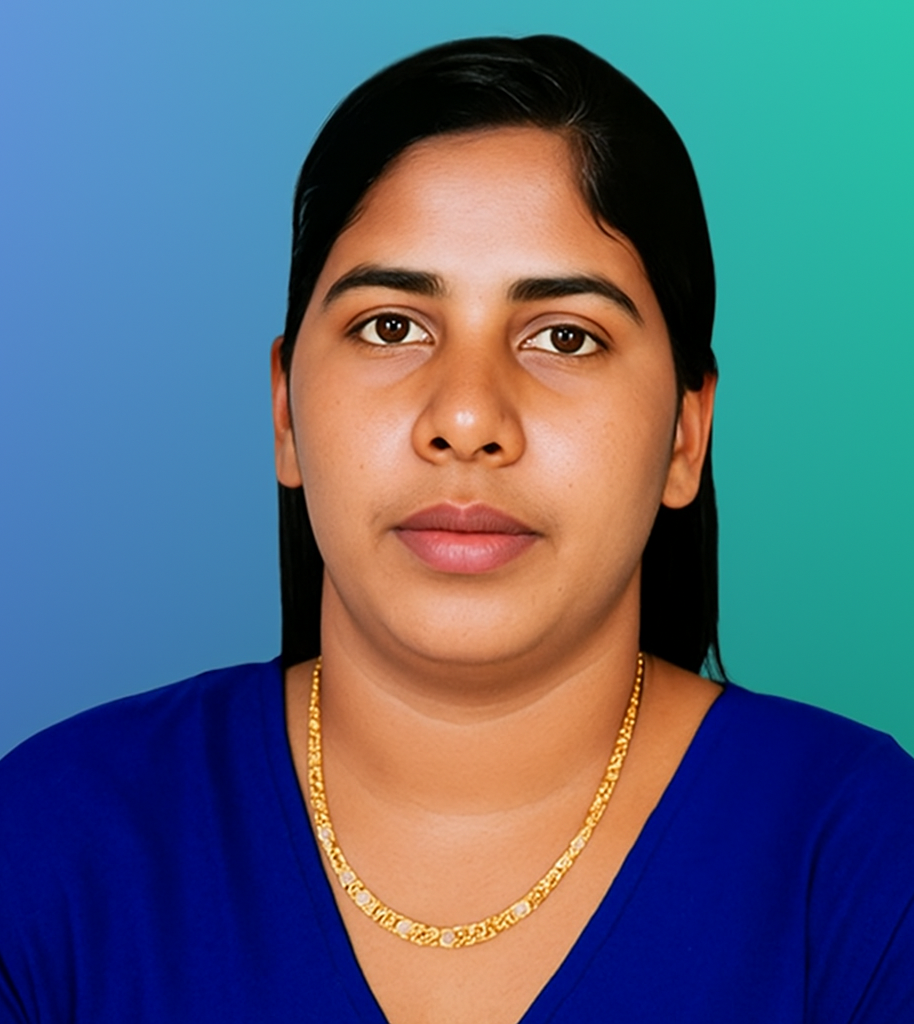
Yemen, July 15,2025
In a major relief, the execution of Indian nurse Nimisha Priya has been postponed, according to sources. Nimisha, who hails from Kerala, was scheduled to be hanged in Yemen on July 16. The latest reports suggest that a significant development has taken place, temporarily halting the sentence that had sparked international concern.
Nimisha’s case has drawn widespread attention and emotional appeals from across India and the global Indian community. The postponement has brought a moment of hope for her family, well-wishers, and the many people who have been campaigning tirelessly for her life to be spared.
Crime
Odisha: Student Who Accused College Professor of Sexual Harassment Dies by Suicide, Father Alleges She Was Pushed to Take Extreme Step
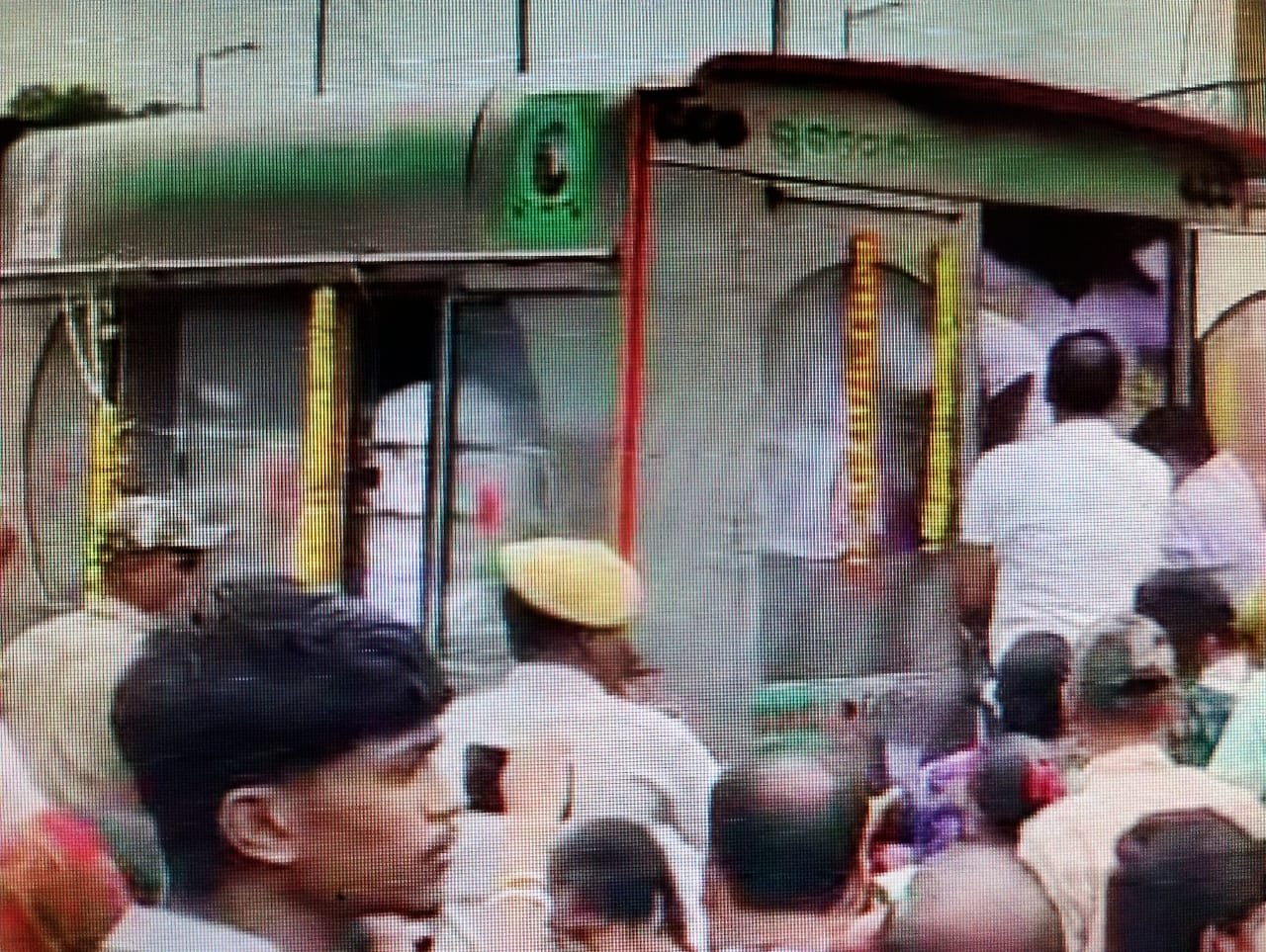
Odisha, July15,2025
Bhubaneswar, Odisha – A college student who had attempted suicide after alleging inaction on her sexual harassment complaint has died while undergoing treatment at AIIMS Bhubaneswar.
The student had accused the Head of Department at Fakir Mohan College in Balasore of sexually harassing her. She took the drastic step on Saturday, allegedly due to frustration over the lack of appropriate action on her complaint. Following the attempt, she was admitted in critical condition to AIIMS Bhubaneswar, where she later passed away.
The student’s father has now come forward with serious allegations against the internal inquiry committee, claiming that their mishandling and a deliberately misleading report forced his daughter into taking her own life.
Speaking to the media, he said, “We are seeking justice. Merely arresting two individuals won’t suffice. My daughter was mentally tortured and pushed to the edge. The internal committee members are equally responsible. I request the government to take the strictest possible action against them.”
The case has sparked widespread outrage and calls for a thorough and transparent investigation into how the college handled the complaint and whether the internal committee was complicit in suppressing the matter.
As the family mourns their irreparable loss, voices demanding accountability grow louder, raising critical questions about institutional response to sexual harassment complaints in educational institutions.
Crime
Principal Arrested After Student’s Suicide Attempt in Odisha College Over Sexual Harassment Complaint
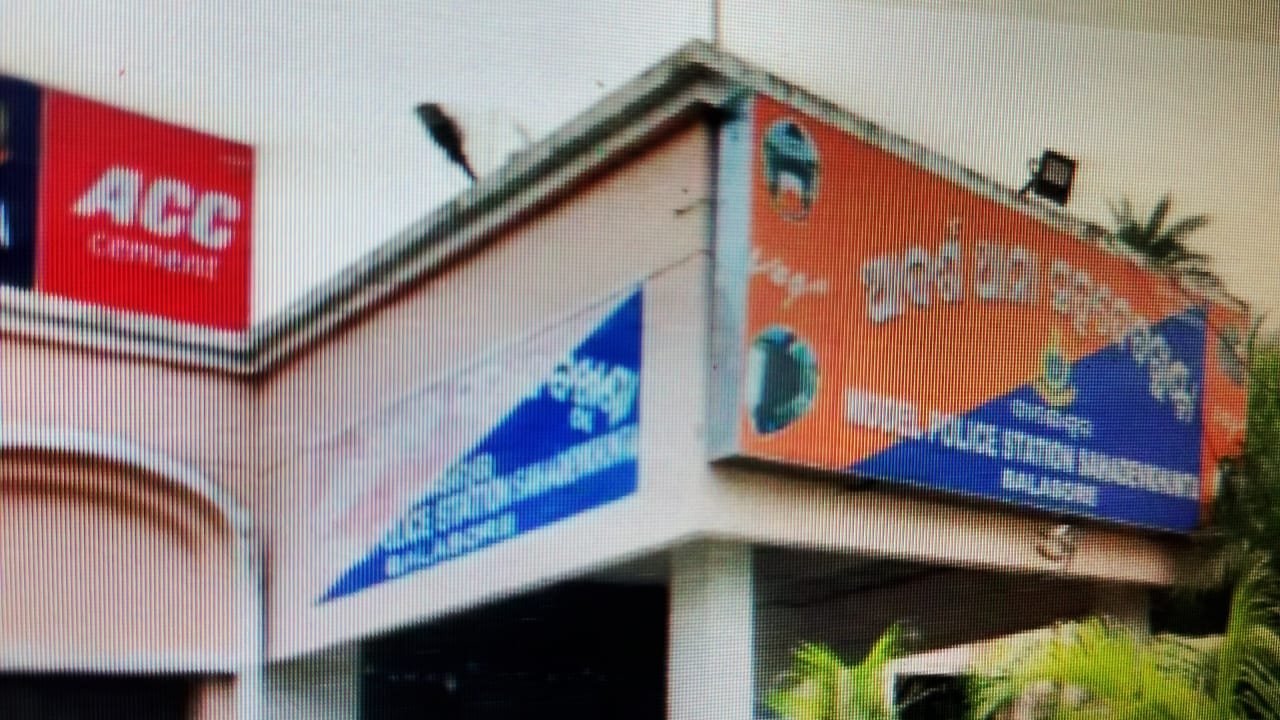
Odisha, July 14,2025
In a shocking development from Balasore, Odisha, the principal of Fakir Mohan College, Dilip Kumar Ghosh, has been arrested by Sahadevkhunta Police following a student’s suicide attempt on campus.
The arrest comes after a female student of the college allegedly attempted suicide on Saturday, accusing a faculty member of sexual harassment. The student is currently in critical condition and receiving treatment at AIIMS Bhubaneswar.
Confirming the arrest, Balasore Superintendent of Police, Raj Prasad, told BBC that the principal was taken into custody for his alleged negligence in handling the student’s repeated complaints.
According to the victim’s family, the girl had been subjected to ongoing sexual harassment for several months. Despite lodging a formal complaint with the college authorities, no meaningful action was taken. Frustrated and distressed by the college’s inaction, the student reportedly attempted to take her own life.
The family had been demanding the arrest of the principal, alleging that he failed to take timely and appropriate action. They also accused the college’s internal inquiry committee of trying to protect the accused teacher, instead of supporting the victim.
Earlier, the police had arrested the Head of the Department (HoD) of the Education Department, Sameer Kumar Sahu, who is the prime accused in the sexual harassment case.
On Sunday, Odisha Chief Minister Mohan Charan Majhi addressed the issue, stating,
“An investigation is underway to understand the full circumstances of the incident. The government will ensure strict action is taken against those responsible.”
The incident has sparked widespread outrage, highlighting the urgent need for stricter enforcement of sexual harassment protocols within educational institutions.
Environment
Literature and Environment Are Both Sources of Sensitivity”Tree is Life: Grand Celebration of ‘Ek Ped – Sampark Ke Naam’ and Poetry Recitation on Environment
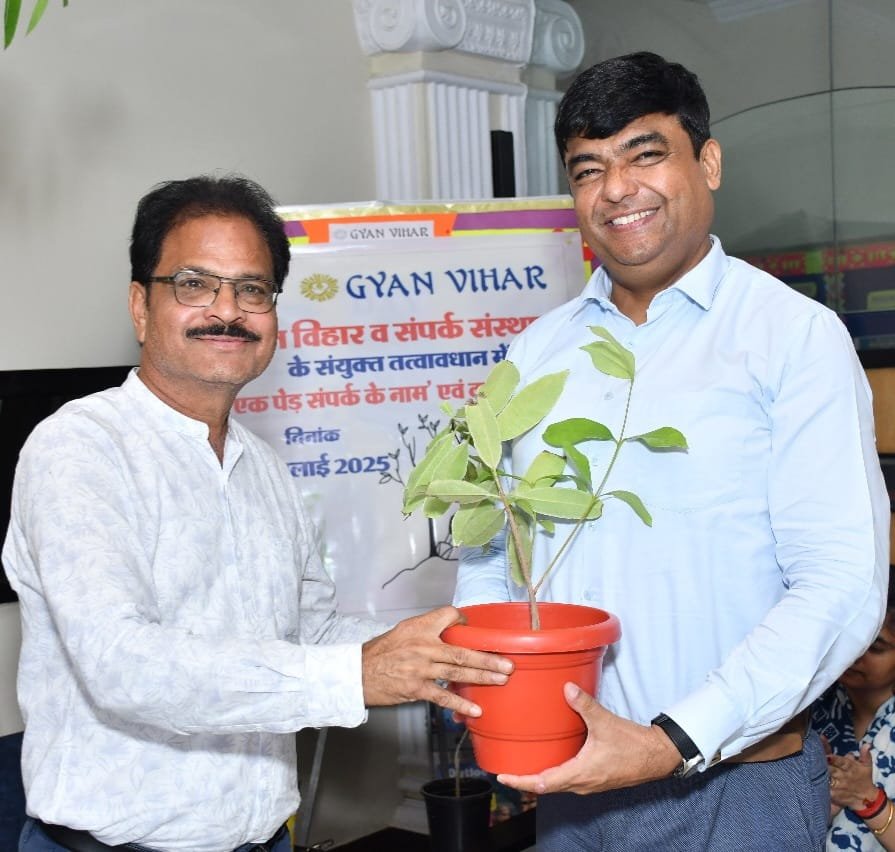
Jaipur, July 14,2025
A Heartfelt Environmental and Literary Initiative by Sampark Sansthan Receives Overwhelming Response at Gyan Vihar School Campus Jaipur.
The joint initiative of Sampark Sansthan and Gyan Vihar School, titled ‘Ek Ped – Sampark Ke Naam’, along with an environmental poetry recital, turned out to be a meaningful confluence of ecological awareness and literary sensibility. Students, teachers, poets, and social workers participated in the event with deep enthusiasm and emotional engagement.
Welcoming everyone, Sampark Sansthan President Anil Ladha remarked,
“This is not just an event, it’s an attempt to connect life and society through tree plantation. We want every individual to nurture a tree as lovingly as they would nurture a relationship.”
Dr. Ritvij Gaur (Principal), present as a special guest, emphasized in his speech,
“Trees are the foundation of our culture and survival. Teaching children to emotionally connect with nature through tree planting is the need of the hour.”

Sampark Sansthan General Secretary and Coordinator Renu ‘Shabdmukhar’ touched hearts with her words,
“This initiative aims to instill in students a sense of responsibility and the spirit of coexisting with trees. When nature and poetry walk together, society becomes truly awakened.”
Veteran poet Prof. Prabodh Govil inspired the audience, stating,
“Literature and environment are both profound sources of human sensitivity.”
Renowned writer Dr. Jayshree Sharma added,
“Trees don’t just give us oxygen, they teach us life values. A poem, a plant, and a thought — these can together change the world.”
Inspiring the young generation, senior poet Anshu Harsh quoted,
“When you walk ahead, many will follow.”
Usha Rastogi’s positive presence brought an energetic vibe to the event.
Program Coordinator Himadri Samarth expressed that,
“No matter what name we give to the campaign, the aim remains the same – to protect the environment.”
He concluded by thanking all the distinguished guests for their participation and support.
The event was beautifully hosted by Seema Walia, whose graceful voice, articulate language, and emotional tone left a lasting impact on everyone present.
The active participation of Gyan Vihar students made the event truly vibrant. When tiny hands touched the soil and planted saplings, it was more than an activity — it became a symbol of emotional bonding with nature.
Students like Charul, along with senior poets — Dr. Neelam Kalra, Renu Shabdmukhar, Himadri, Dr. Kanchana Saxena, Sonal Sharma, Dr. Anju Saxena, Avinash Joshi, Dr. Punita Soni, Kavita Mathur, S. Bhagyam, Rao Shivraj, Dr. Deepali, Vijayalakshmi, Sushila Sharma, Sushma Sharma, Meena Jain, Mahesh Sharma, and Nisha Jha — delivered powerful poetic performances centered on environmental consciousness. The students not only listened but also absorbed the essence of literature as a tool for raising awareness about nature.
The event sent a strong message — if the young generation connects with nature today, the future will be safe, beautiful, and full of hope.
Art
Sattva, Rajas, Tamas” Come Alive on Canvas – Dr. Renu Shahi’s Indian Philosophical Art Shines in Sri Lanka
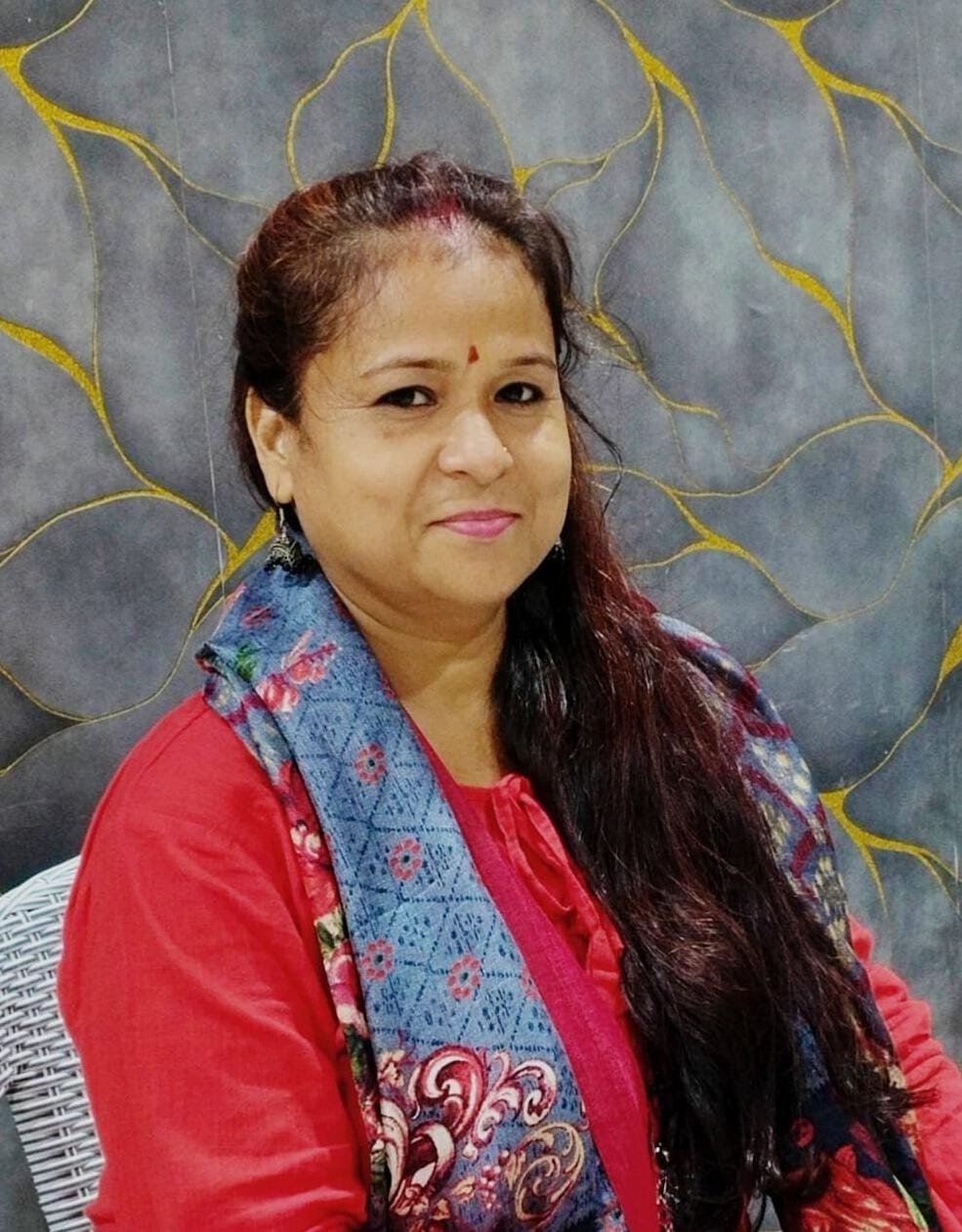
Colombo/Jaipur, July 14,2025
In a vibrant celebration of artistic expression and cultural wisdom, Indian artist Dr. Renu Shahi has drawn deep admiration for her spiritually inspired paintings at an international art exhibition titled “Uncharted”, held at the Curado Art Space in Colombo, Sri Lanka.
Organized by the Rainbow Art Group, New Delhi, this cross-border exhibition featured 49 contemporary artists from six countries, each offering their unique visual interpretations. Amid this diversity, Dr. Shahi’s works stood out — not only for their aesthetic depth but also for their philosophical grounding.
Her three paintings, inspired by verses from the Bhagavad Gita, revolved around the three fundamental qualities of human nature: Sattva (purity), Rajas (passion), and Tamas (inertia). Through rich symbolic imagery and subtle layering, she represented these gunas not merely as abstract ideas, but as divine forces shaping the human experience. Each artwork intertwined color, mythology, and introspection into a single visual meditation.
The exhibition, which ran from July 4th to 10th, was inaugurated by Shanila Alles, Director of Curado Art Space, and curated by Virendra Kumar, the visionary founder of Rainbow Art Group. The group’s mission is to highlight artists who explore Indian culture, spirituality, and heritage through their canvas, offering them a global stage to be seen and heard.
“For us, art is a language that speaks beyond words,” said Kumar. “It transcends geography and unites minds — whether you’re from Jaipur or Jakarta.”

Alongside Dr. Shahi, notable artists such as Banita Rani Singh, Bhaskar Ghosh, Dr. Chetna Agarwal, Manju Saad, Manoj Chakravarty, and Nayana Mevada, among others, showcased their works. Artists hailed not just from India but also from Nepal, Sri Lanka, Qatar, Indonesia, and Belarus. Each piece was a window into the artist’s soul — and some of those windows were so captivating that a few artworks were sold, a testament to the audience’s deep connection with the themes.
Rainbow Art Group has, over the years, emerged as a powerful platform nurturing both emerging and established talent. Its exhibitions reflect a belief that “art needs no passport — it is the purest dialogue between cultures.”
Dr. Renu Shahi’s series served not just as paintings, but as philosophical experiences — introducing Sri Lankan viewers to the timeless teachings of Indian scriptures, not through sermons, but through strokes of color, layers of thought, and a visual silence that speaks louder than words.
Crime
Don’t Hang Nimisha Priya in Yemen: Supreme Court to Hear Plea Today Seeking Diplomatic Intervention to Save Kerala Nurse
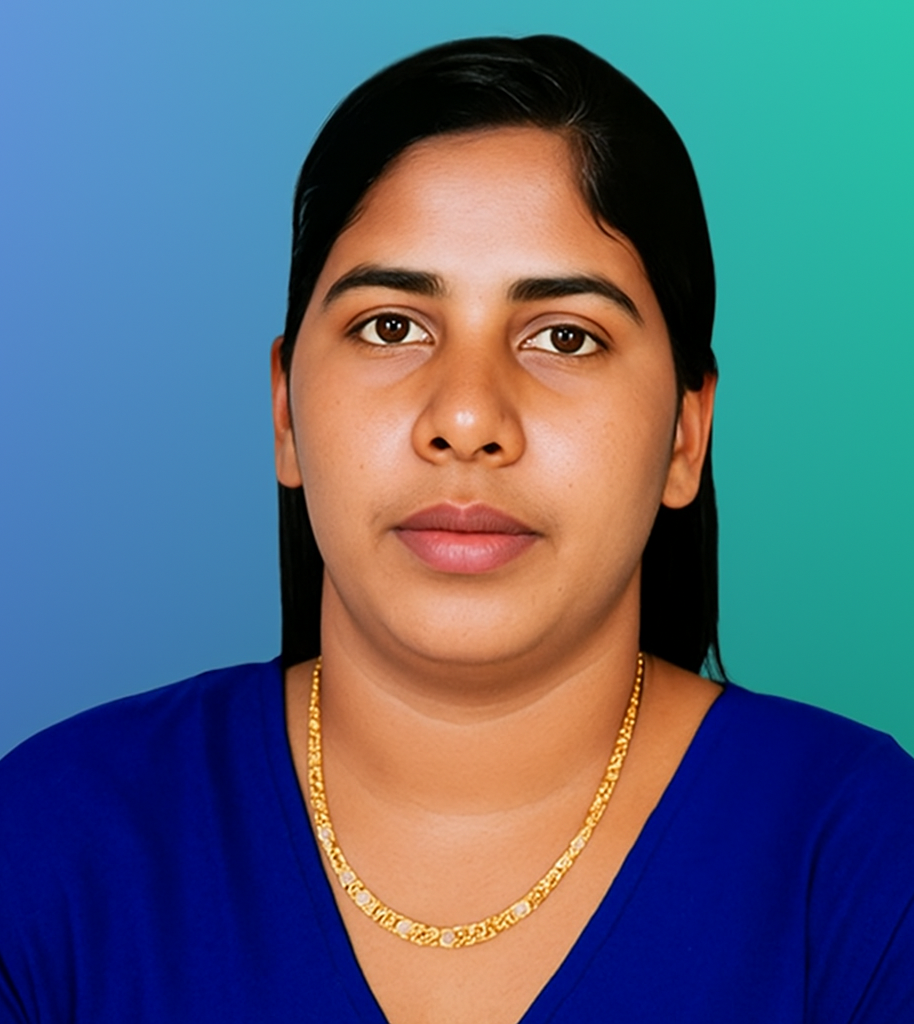
Contents
New Delhi, July14,2025
The life of Indian nurse Nimisha Priya, who has been sentenced to death in Yemen, hangs by a thread. With the execution scheduled for July 16, her family and well-wishers are making desperate last-minute efforts to save her.
Today, the Supreme Court of India will hear a critical petition filed by the Save Nimisha Priya International Action Council, urging the Indian government to step in diplomatically and prevent her execution. The matter will be taken up by a bench comprising Justice Vikram Nath and Justice Sandeep Mehta.
What is Nimisha Priya Accused Of?
According to Yemeni court documents, Nimisha, who has been living in Yemen since 2008, was accused of murdering her business partner Talal Abdo Mahdi. Reports allege that after the murder, she, along with another nurse, dismembered his body and disposed of the remains in a water tank.
However, Nimisha’s family strongly denies the murder charges. They claim that Nimisha did not intend to kill Talal. According to them, she only administered an injection to render him unconscious so she could retrieve her confiscated passport. Tragically, due to an overdose, he died — making it an accidental death, not murder.
Pleas for Mercy Rejected
In a heartbreaking turn of events, Nimisha had earlier filed an appeal against the death sentence in Yemen’s Supreme Court, but it was rejected. She also made a mercy plea to the President of Yemen, which too was denied.
A Mother’s Last Hope
Nimisha’s family has made multiple appeals for help — reaching out to both Kerala Chief Minister Pinarayi Vijayan and the central government. CM Vijayan personally wrote to Prime Minister Narendra Modi, urging him to intervene and use all diplomatic channels possible to halt Nimisha’s execution.
The Ministry of External Affairs (MEA) has stated that it is doing all it can to provide support to Nimisha’s family and is in touch with relevant authorities.
Why This Case Matters
This is not just a legal case; it’s a human story of desperation, fear, and a plea for compassion. A mother, a nurse, an Indian citizen – Nimisha Priya is facing death in a foreign land. Her family is fighting to give her a second chance, hoping that diplomacy and humanity will prevail where legal appeals have failed.
As the clock ticks towards July 16, all eyes are now on the Supreme Court of India and the Indian government — will they act in time to stop the execution and bring Nimisha home alive?
Nimisha Priya, Yemen death penalty, Indian nurse, diplomatic intervention, Supreme Court India, Save Nimisha Priya campaign, Kerala news, Talal Abdo Mahdi, Pinarayi Vijayan, Narendra Modi

 Education1 month ago
Education1 month agoKota ICICI Bank Staffer Swindles ₹4.5 Crore, Gambles It All on Stock Market

 Bollywood1 month ago
Bollywood1 month agoHousefull 5 Movie Review: Akshay Kumar, Riteish Deshmukh Bring Laughter and Twists in Bollywood’s Biggest Comedy Franchise

 Education3 weeks ago
Education3 weeks ago11 Powerful Reasons Why DAV International Yoga Day Jaipur Uplifted Spirits!

 Cricket1 month ago
Cricket1 month agoBengaluru Chinnaswamy Stadium Stampede: 11 Dead, 33 Injured in RCB Victory Parade Chaos

 Education3 weeks ago
Education3 weeks ago7 Inspiring Highlights of DAV Foundation Day Jaipur Celebration – Amazing Vedic Legacy Revealed!

 Education2 weeks ago
Education2 weeks agoEmpowering Educators: A Three-Day Learning Journey at DAV Centenary Public School, Jaipur

 Credent TV3 weeks ago
Credent TV3 weeks agoVIBGYOR Summer Camp Ends on a High at DAV Centenary Public School, Jaipur

 Election1 week ago
Election1 week agoDAV Centenary Public School, Vaishali Nagar, Jaipur Event Report: Talent Hunt Show
































